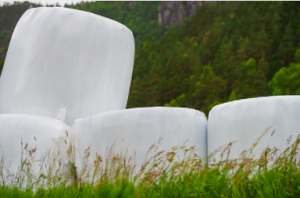The silage wrap is the latest trend in the area of gardening. These wraps produced by using various plants are designed to cover ground that would otherwise be hard and thick, making it unusable for cultivation. The plants used in the wrappers are grown in greenhouses and cured for a few weeks to ensure that they are dense enough to withstand the cold. After they have been ready, they are rolled out and fastened to the earth. A conveyor belt moves them through the garden area at a constant speed. As the conveyor belt moves them, the plants are turned into long strands of hay, tied together and tied to the belt again.
 In addition to being a useful agricultural product, the silage wrap can be useful for protecting your patio furniture from the elements or as an alternative to conventional outdoor storage sheds. You can place these wraps over umbrellas, around decks or on patio decks. If you use the bale wrap, it is important to apply a clear protective coating to prevent UV damage. The clear protective coating will prevent any sunlight from penetrating through to the plant, preserving its quality and allowing the plant to get the nutrients it needs to thrive.
In addition to being a useful agricultural product, the silage wrap can be useful for protecting your patio furniture from the elements or as an alternative to conventional outdoor storage sheds. You can place these wraps over umbrellas, around decks or on patio decks. If you use the bale wrap, it is important to apply a clear protective coating to prevent UV damage. The clear protective coating will prevent any sunlight from penetrating through to the plant, preserving its quality and allowing the plant to get the nutrients it needs to thrive.
The silage wrap is produced from a variety of materials, including plastic and paper. The two most popular ways of producing the plastic sheeting for your silage wrap are either using roll forming equipment in a factory setting or by using the machine called a roll forming machine. These methods produce very high-quality plastic silage wrap that are excellent candidates for both indoor and outdoor applications. Some companies who manufacture plastic sheets will also help you recycle unused or unwanted plastic sheeting into a resource that benefits nature. Many companies will take unwanted or unused bale wrapping and convert it into raw material to create more of the same product, like silage wrap. For example, if a company produces ten pounds of rolls of used cedarwood and uses that same raw material to make ten rolls of silage wrap, they will make ten tons of silage wrap.
The most common way the silage wrap is made is by using a large, industrial-type machine called a roll forming machine. These machines have vacuum forming equipment that forces the plastic into long strings. Each string of plastic is approximately ten inches in length and about half an inch in diameter. The machine uses the vacuum from the plastic into sheets that are fed into feeders that get the plastic directly into the air for curing. The curing process occurs throughout the entire drying cycle and is an essential step of the silage wrap manufacturing process.
The manufacture of silage wraps and bales is a very competitive industry. Many suppliers of different sized rolls of wrap around forage can custom make what you are looking for. You can even choose the colour of the wrapping and more. Some suppliers can even customize the wrapping and then ship it directly to your customer. It can give you a higher profit margin on your forage wrap and baled silage wrapping.
